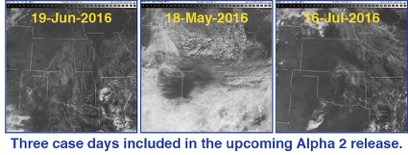Transitioning LASSO from Pilot to Operations
Published: 18 June 2017
Wrapping up two years of development and testing, the Large-Eddy Simulation (LES) ARM Symbiotic Simulation and Observation (LASSO) project’s pilot phase is now beginning to wind down. Next up is a soft transition to Phase 2, the operational phase that will initiate routine observation and modeling operation at ARM’s Southern Great Plains (SGP) atmospheric observatory, where the pilot was run to support the reconfiguration and upgrade of the observatory.

That upgrade was planned, in part, to bring LES capabilities to the SGP to support future modeling strategies. This symbiotic relationship is part of ARM’s decadal vision to increase the Facility’s relevance to scientific users—especially earth system modelers—by providing them with the measurements and value-added products that will best advance their research.
“The pilot phase went well,” says Bill Gustafson, LASSO’s principal investigator and a scientist at Pacific Northwest National Laboratory, “but we’re still studying some features and impacts of observations on the LES, both from the standard set of SGP instruments and from new ones that were especially deployed to support LASSO.”
Phase 2 will involve formally recommending and adopting the scope and configuration of LASSO for shallow convection, implementing LASSO software within ARM’s infrastructure, and beginning the ongoing process of building a library of LES simulations of shallow convection. The expansion of cases with the operational framework will begin this fall.
In the nearer term, the team is working on finalizing the Alpha 2 release, which will be available via the ARM Data Archive this summer. Alpha 2 will have simulations from 13 cases during 2016, a much larger sample than the five 2015 cases released with Alpha 1. Unlike Alpha 1, Alpha 2 will include a forcing that includes ARM wind, temperature, and moisture profiles within the multiscale data assimilation process. The LASSO team has also worked to expand the data bundles, which are products that match measurements and models, to include additional cloud observations to compare with the LES output.

Long term, the team aims to expand coverage to other sites and other atmospheric phenomena. For LASSO users, that’s an exciting prospect. “Stay tuned,” says Gustafson. “We’re just getting started.”
ARM’s LASSO project is a major initiative to provide the data required to compare models to measurements, making it easier to work between the two areas. It’s one of a few instances in which a major observational facility has supported its own large, systematic modeling activity. LASSO aims to accelerate dialogue between modeling needs and observational capabilities and limitations, thereby improving understanding of the Earth system.
As Andy Vogelmann, LASSO co-principal investigator and atmospheric scientist at Brookhaven National Laboratory puts it, “We want to make the information as transparent as possible so it’s useful to a broad range of users.”
The ARM Climate Research Facility is a DOE Office of Science user facility. The ARM Facility is operated by nine DOE national laboratories.
Keep up with the Atmospheric Observer
Updates on ARM news, events, and opportunities delivered to your inbox
ARM User Profile
ARM welcomes users from all institutions and nations. A free ARM user account is needed to access ARM data.


















